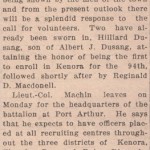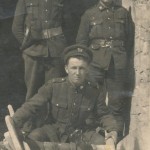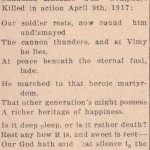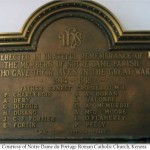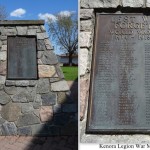

| Personal Details | |
| Date of Birth | October 21, 1897 |
| Place of Birth | Fesserton, Ontario |
| Country | Canada |
| Marital Status | Single |
| Next of Kin | Albert James Dusang (father), Kenora, Ontario |
| Trade / Calling | Druggist's Clerk |
| Religion | Roman Catholic |
| Service Details | |
| Regimental Number | 198264 |
| Service Record | Link to Service Record |
| Battalion | 13th Machine Gun Company |
| Force | Canadian Expeditionary Force |
| Branch | Canadian Machine Gun Corps |
| Enlisted / Conscripted | Enlisted |
| Place of Enlistment | Kenora, Ontario |
| Address at Enlistment | Kenora, Ontario |
| Date of Enlistment | November 4, 1915 |
| Age at Enlistment | 18 |
| Theatre of Service | Europe |
| Prisoner of War | No |
| Survived War | No |
| Death Details | |
| Date of Death | April 9, 1917 |
| Age at Death | 19 |
| Buried At | Memorial marker in Nine Elms Cemetery, Thélus, France |
Dusang, Hilliard Rusteed
Private Hilliard Rusteed Dusang was the first Kenora lad to join the 94th Battalion, signing up at age 18. He arrived in France in September 1916 and he was killed at the Battle of Vimy Ridge seven months later.
Hilliard was the son of Albert James Dusang and Caroline Laura Gill. Albert and Caroline were both born in Ontario and they were married in 1894 in Fesserton, a small village on the eastern tip of Georgian Bay. Albert worked as a lumberman and they had at least twelve children, seven sons and five daughters, most of them born in Fesserton. Hilliard, their third child, was born on 21 October 1897. Around 1910 the Dusang family moved to the town of Kenora in northwestern Ontario where Albert continued to work in the lumber industry. At the time of the 1911 census Hilliard was 13 and working as a messenger in a store. For a few years before he enlisted he was a druggist’s clerk at Johnson’s Pharmacy.
Hilliard signed up with the 94th Battalion in Kenora on 4 November 1915, two weeks after his 18th birthday. He was the first Kenora lad to join the battalion. It was based in Port Arthur and recruited in towns throughout northwestern Ontario. Hilliard left Kenora with the other volunteers on 25 May 1916, headed to Port Arthur to join the rest of the battalion. On 9 June the men entrained for Quebec and they spent a short time at Valcartier, a military camp northwest of Quebec City, before embarking from Halifax on 28 June 1916 on the SS Olympic. In England the recruits were absorbed into reserve battalions to be used as reinforcements for other units. A week after he arrived Hilliard was transferred to the 17th Reserve Battalion.
In August 1916 Hilliard contracted German measles and he spent two weeks in the military hospital at Shorncliffe Camp in Kent. A month later he was transferred to the 16th (Canadian Scottish) Battalion and sent to France, arriving there on 22 September. He joined his new unit in the field in October. The 16th Battalion was in the 3rd Infantry Brigade, 1st Canadian Division. That fall all four Canadian Divisions were at the Somme and the 16th Battalion took part in several operations including the assault on Regina Trench.
In January 1917 Hilliard was transferred to the 13th Canadian Machine Gun Company, a unit that had just been organized that month. It was made up of volunteers from the 1st Division’s machine gun sections as well as some infantry. For the next 2-1/2 months the men trained in the area west of Lens in France. At the end of March some of them were sent to the front lines while the rest of the Company formed work parties and continued with advanced training. By 4 April the men were ‘thoroughly instructed with the duties of the unit‘ for the coming offensive – the Battle of Vimy Ridge (9-14 April 1917). Hilliard’s unit moved forward into position on 8 April and the assault began at 5:30 the next morning, Easter Monday. At 6:45 am the 13th Company ceased firing and moved to a new position. As they crossed an old trench system five men were killed and 11 were wounded by heavy shell fire. They continued firing from new positions during the day and into the night, suffering five more casualties. Hilliard was one of the fallen that day, killed by a German artillery shell.
A month after the battle Thomas Purvis, a fellow soldier who was also with a machine gun unit, wrote to Hilliard’s mother saying he was the one who found Hilliard’s body and, ‘he got a good burial Mrs. Dusang & there was one Kenora boy present, namely myself.‘ After the war Hilliard’s grave could not be found and a memorial marker was erected for him in Nine Elms Military Cemetery in the village of Thélus, France. Nine Elms was first used in April 1917 and many of the Canadians buried there died on 9 April. Hilliard is commemorated on the Kenora Cenotaph, the Kenora Legion War Memorial and the Notre Dame du Portage Roman Catholic Church WW1 memorial plaque.
His brother Everett Dusang was conscripted in February 1918. He served for fifteen months including four months in Siberia, returning to Canada in May 1919. Their father passed away in 1950 and their mother in 1966. They are both buried in Lake of the Woods Cemetery in Kenora, along with other family members.
By Becky Johnson
